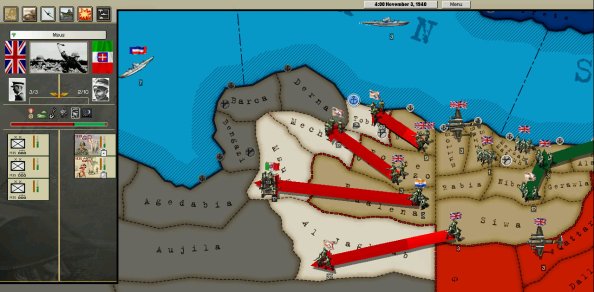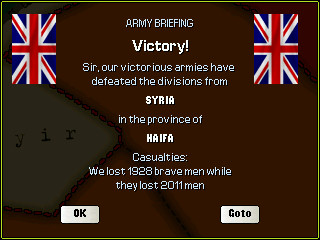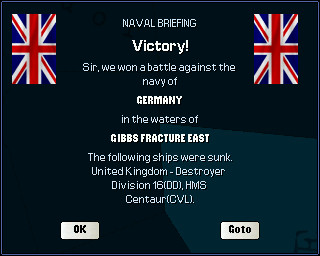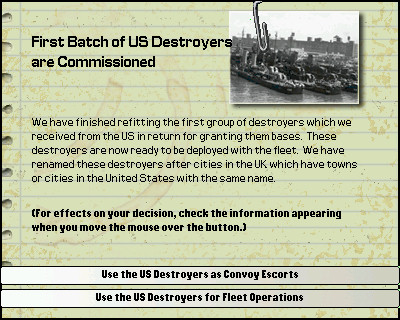The two months following our recapture of Egypt are spent pushing into Libya and generally making life difficult for the Italians. Germany, meanwhile, is making life hard for us in the Atlantic. Things are also kicking off in the Middle East.
Libya
To date, British and Commonwealth forces, with the welcome addition of an expeditionary corps from South Africa, have retaken all of Egypt. It’s now time to push into Libya and defeat the Italian forces in North Africa completely. Our Supreme Leader’s initial plan had been to secure Libya’s coastal regions and launch an immediate attack on Italy itself, leaving the remaining Italian divisions in North Africa cut off and out of supply. However, with our earlier disastrous loss of the majority of our transport fleet, plans have changed. We’ll keep our boys occupied by defeating Italian forces throughout Libya in detail while waiting for transport squadrons to roll off the production line (by the 20th December, one squadron is in the theatre – hardly enough for launching an invasion).
Our armoured corps has already defeated the Italian counter-attack into Sollum, with only a small loss of organisation, so spearheads the assault on Bardia, opening the way to Tobruk, followed by the bulk of British forces in the region and one of our two HQ units. Our South African corps and our remaining divisions are delegated to follow through to the south, after dealing with the last retreating Italian divisions in Egypt.
Things go largely according to plan. A small hiccup occurs when the Italians managed to land a division in the undefended province of Fuka. Luckily, we have a corps of three divisions still in the area, who swiftly repel the invaders:
Fleet Eastern Mediterranean, patrolling the coast of Alexandria, jumps and destroys the unescorted transport flotilla as it exits the region. It would have been nice if they’d caught them before landing their troops. Oh well. Any further amphibious landings by Italy will only be expensive irritations, but irritations they will be. For this reason, we will have to be more careful with keeping coastal provinces garrisoned.
Our initial push goes well. This is the situation as of 3rd November, 1940. Tobruk and Mechili have fallen, but the Italians in Msus are holding out against our South African corps:
Italian resistance is somewhat stiffer from this point on, and our brave South African allies take the brunt of it (no doubt this will lead to bitter cultural memories of the ruthless British exploitation of South African troops for decades to come). Msus and Derna especially prove difficult, with the Battle of Msus being the first in which we have taken heavier casualties than the enemy:
There are a few reasons for this:
- Pushing too hard. Our British forces can take it, winning most battles with only minimal losses in organisation, but the South Africans are fielding an older model of division, without any specialised brigades.
- Although some of the divisions we are fighting are those that have already taken a beating in Egypt, some are fresh and dug in.
- The Italians are deploying modern divisions for the first time, and their supply is well and truly intact.
- Almost zero infrastructure to help our boys reorg.
- Generally difficult terrain favouring the defenders.
Still, we’re facing slow going rather than any form of setback. By early December, Italian forces have been entirely driven out of Cyrenaica. They still have a few divisions to the West, however, including at least one fresh armoured division, so the fight is far from over. Our forces are reorganising, ready to push forward, but it will be some time yet before things are brought to a close, due to the large distances and poor infrastructure. Our tactical bombers are also being brought forward to bases in Barca and Bengazi, ready to start softening up Sicily and Southern Italy.
The Mediterranean
Of course, operations in North Africa aren’t going to get far without associated air and sea support in the Mediterranean. Supplies are being convoyed in around the Cape of Good Hope, so we don’t need to worry about that. We do, however, need to worry about dominating the theatre in time for an assault on Italy itself. Cutting the Italian’s North Africa forces off from supply and reinforcement is a secondary goal, but unfortunately one at which we have not really excelled.
We have three major naval forces operating in the area:
- Battlegroup Hood, consisting of HMS Hood accompanied small group of heavy cruisers and support vessels, operating out of Gibraltar. They’ve been conducting operations in the Western Mediterranean, staying well clear of Italian and Germany land based air forces until we can establish air superiority over the Tyrrhenian Sea.
- Fleet Malta, a large independent force which has remained bottled up in Malta itself, save for the odd very specific mission.
- Fleet Eastern Mediterranean, another large force operating out of Alexandria. They’ve seen plenty of action.
These three fleets are supported by a small air superiority group operating from Malta, a couple of patrol bomber squadrons based in Gibraltar (hunting subs) and a few of our own submarines on convoy raiding duty. They’ve also been joined by one squadron of short range naval bombers, and now that things are more under control in North Africa, our one squadron of air superiority fighters operating over Libya will join in over the Mediterranean.
Editor’s note: as per my fluff settings, I’m pretending that land-based naval bombers are as much a threat as they were in historical reality, so I’m avoiding operating fleets where I don’t have air superiority.
As noted above, Fleet Eastern Mediterranean, led by HMS Warspite, have spent most of the war so far patrolling the Coast of Alexandria. They’ve had a number of encounters. This was a second Italian landing operation, which would have been much more serious for our rear areas had it not been intercepted:
This was closely followed by the kind of decisive action for which we have been looking:
We can’t be complacent, however. The Italian Navy still has some capitals up its sleeve, and this action has temporarily but Fleet Eastern Mediterranean out of action. Another of our County class cruisers barely limped back to Alexandria after the engagement, leaving the group short on capital ships. This prompted our Supreme Commander to dispatch HMS York, escorted by one another heavy cruiser, the long way around Africa, to join them. They arrived in early December and the fleet is back in action.
RIP HMS Diomede [editor’s note: yet another light cruiser bites the dust… in reality she survived the war]

RIP HMS Dauntless [editor’s note: although one of HMS Diomede’s sister ships, they never served together; in reality she survived the war without seeing action.]
The Middle East
Things have also kicked off with Lebanon and Syria in these last two or three months. Iraq is still sitting beside the sidelines, but we are planning on hostilities from them in the near future. The Syrians take Haifa and Golan before being taught a stiff lesson in superior man- and fire-power. A pair of tactical bomber squadrons are tasked with softening them up whilst a force of four divisions (British and allied) are diverted to sort them out.
To give them their due, both the Lebanese and Syrian troops put up a good fight. They’re in supply, they’re fresh and they’re fighting in defensible terrain. Haifa especially is a hard fight. This was two of our divisions versus one of theirs:
However, by the middle of December it’s all over. Both Lebanon and Syria have fallen.
The Battle of the Atlantic
So far, so not so good. In fact, the Kriegsmarine’s U-boats have been giving us a beating, with convoy loses all over the Atlantic, from the Faroes Gap to the Azores and even into the North Sea. Almost the entire theatre is covered by patrol bombers and ASW groups, but U-boats hard to find. and if they are found, a kill is far from guaranteed. This was hardly a victory, although some damage was done to the U-boat squadron involved:
It probably didn’t help that this engagement was conducted in blizzard conditions, rendering HMS Centaur’s planes next to useless. The loss of this modern light carrier is frustrating indeed.

RIP HMS Centaur [editor’s note: in reality, although laid down in 1944, she wasn’t actually commissioned until 1953]
In other news…
As we noted in our last report, our Supreme Leader had been somewhat neglecting the build up in the Far East. No more! We have been slowly but surely organising the large number of India divisions over which we have control, and have initiated the deployment of our own front-line troops to the area. This was a laborious process which involved rebasing our two long-range transport flotillas to East Africa from the East of England and moving suitable divisions to the area so that they can be picked up. Although long-ranged, these vessels don’t carry the fuel to get where we want to go in one hop, so further laborious arrangements will have to be made.
The Battle of Britain has also been hotting up, with daily battles in the skies of England and over the English Channel. It’s hard to say who is winning and who is losing at this point. Our own strategic bomber force also made a tentative foray over mainland Europe. Let’s just say that it didn’t go well.
There were also political machinations afoot. Germany created Croatia as a puppet state before annexing the rest of Yugoslavia. Italy, deciding that its plate wasn’t quite full enough in North Africa, declared war on neutral Greece. Neville Chamberlain has also passed away, alas.
Finally, let’s have a look at the balance of inflicted losses between Italy, Germany and our own naval forces:
Losses
- One MTB squadron
- Six destroyer divisions
- Two County-class heavy cruisers
- Three WWI-era aircraft carriers
- One modern light carrier
- Eight light cruisers
- One battleship
- Three long-range and two medium range transport squadrons
German vessels sunk
- 13 submarine squadrons
- Four destroyer divisions
- One light cruiser
- Two heavy cruisers
- Two transport squadrons
Italian vessels sunk
- 10 destroyer divisions
- Six light cruisers
- Two heavy cruisers
- Two battle cruisers
- Two battleships
- Six transport squadrons
This is definitely an improvement over previous months, especially against Italy. Both Axis powers both have significant naval forces remaining, however, especially Germany’s U-boat arm… and before too long, we’re going to have to start transferring forces to the Far East.









That’s some serious naval action so far. Do you plan to decimate your foes with air-to-ship missiles?
And how do you sink those enemy transports? In my experience, they start the engagement at 200km range and get away befor I can close the range.
Air to ship missiles are a way off yet! In my fluff settings I’ve banned myself from pushing technology beyond it specified year. I’ve got quite a lot of naval building going on though, so that and superior tactics will have to suffice for now.
I’m not 100% sure about the transports. In the one engagement I had time to watch, it did start at long range (I can’t remember how long, might have been 200km), but it was closed rapidly, as transports are very slow. That wasn’t one of the ones where the transports were by themselves though. It may be that when they have escorts the battle starts at closer range. I’ll keep a closer eye on any future transport engagements and let you know!